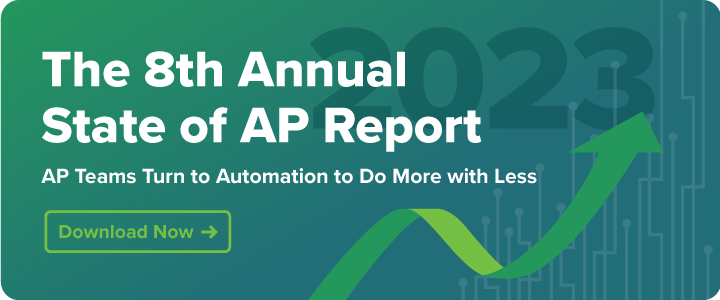No matter your business’ size or industry, healthy cash flow is critical for operations and financial stability. But a key component of cash flow balance — accounts payable — is often overlooked.
Accounts payable (AP) is inherently tied to a business’ financial stability. It includes the amounts owed to vendors, suppliers, and other stakeholders for goods or services. Essentially, it’s the outstanding credit a company needs to settle.
Let’s review the role of accounts payable on cash flow and dive into best practices for optimizing cash flow.

How AP Impacts Cash Flow
Accounts payable, cash flow, and a business’ financial stability are closely linked. Changes in AP have a direct impact on cash flow management in the following ways:
The Consequences of a Decrease in AP
A decrease in accounts payable implies that the business is paying off its debts faster. While this may appear positive at first glance, it can strain cash flow, especially if a company can’t cover the reduced AP. As a result, it’s important to strike a balance between timely payments and adequate cash reserves.
The Consequences of an Increase in AP
Increasing accounts payable by extending payment terms can improve cash flow in the short term. By delaying payments, businesses can retain more cash for other essential expenditures. However, late payments can result in penalties and strained vendor relationships.
As evidenced by the above, days payable outstanding directly influences cash flow. There is no such thing as a bad DPO, but it’s important that businesses be strategic when decreasing or increasing payment terms.
8 Tips to Improve Cash Flow
A streamlined AP process helps businesses better monitor, manage, and forecast their cash flows. The following strategies can increase AP transparency and efficiency:
1. Optimize the Payment Mix
It’s no secret that checks are expensive, yet 33% of companies are still using paper checks for a majority of their AP spend. By reducing check usage, companies can reduce wasted spend.
With MineralTree, companies can leverage the History of Payments report to determine ways to further optimize the payment mix. AP teams can see all invoice payments alongside the types of payment (such as check and ACH). By gaining a comprehensive overview, companies can better understand which vendors may be most beneficial in terms of virtual card enrollment based on volume and total spend. AP teams can also identify ways to further reduce their check usage.
2. Earn Rebates Through Virtual Cards
By switching to electronic payment methods like virtual cards, you can earn rebates and simplify payment processes. Businesses across industries are seeing the advantage of virtual cards, with over 70% of AP teams shifting a portion of their spend to ePayments in 2022.
Quartzy, a life science product distributor, increased its cash flow and earned $100,000 in rebates by implementing MineralTree’s SilverPay virtual card to make payments. Bheem Bhatia, Vice President of Finance at Quartzy noted, “SilverPay allows us to contribute something to the company’s bottom line, which is not always an option in accounting.”
Unfortunately, 40% of AP teams noted that contacting or enrolling vendors is a major hindrance to converting more AP spend to electronic payments. MineralTree can offload some of this work by comparing a company’s vendors with our growing network of businesses already accepting MineralTree virtual cards. Additionally, we can help enroll strategic suppliers in virtual card payments and offer continuous enrollment campaigns to maximize rebates.
3. Get an Accurate View of AP Expenses
Because accounts payable, cash flow, and financial health are linked, you need an accurate view of AP to understand its impact on your business’ financials. However, this can be difficult to achieve without AP automation. Gaps for the finance team exist when AP lacks the visibility into real-time invoice status or does not have the capability to report on invoice data before the invoice has been processed.
Implementing an AP automation solution, such as MineralTree TotalAP, allows for precise analysis of invoice data. By immediately capturing and digitizing invoice data upon receipt, businesses can effectively leverage AP analytics and make informed decisions to optimize cash flow.
4. Be More Strategic
By automating routine tasks within the AP process, you can optimize your AP workflow and shift your focus to strategic initiatives. For example: By leveraging MineralTree’s AP automation platform and payment execution timelines, you can determine whether to extend DPO to increase cash flow or reduce it to foster stronger relationships with strategic vendors.
5. Reduce Duplicate Payments
Duplicate payments can drain cash flow, damage vendor relationships, and hurt your bottom line. There are a number of reasons duplicate payments can occur, including human error, duplicate data in an ERP system, or lack of visibility into the process. Automation tools help your team flag and prevent duplicate transactions before they occur, safeguarding financial resources and improving cash flow forecasting.
6. Reduce Late Payments
About 71% of companies agreed that supplier relationships grew increasingly important over the past year. However, overdue payments can drastically impact relationships with suppliers. Not only do these late payments strain vendor relationships but also incur additional fees and penalties.
Implementing effective AP automation processes ensures timely payment execution, minimizing the risk of late payments and improving cash flow stability. With MineralTree, AP teams can also set payment dates in the platform, so invoices can get paid at a preapproved date.
7. Implement Strong Internal Controls
Detecting and preventing vendor and invoice fraud is key for maintaining cash flow balance. Fraudulent invoices can distort cash flow projections and make it challenging to optimize cash flow.
AP automation tools automatically check the information against all records in the ERP system and perform 2-way or 3-way PO matching, alerting your AP team of any mismatches. As a result, you can gain a more accurate overview of expenses.
8. Improve Efficiency Across the Back-Office
Inflation has become a big concern for companies, looking to ensure that no dollar is wasted. When companies embrace end-to-end AP automation, they are able to reduce the time that is being spent on manual tasks, while improving productivity across their finance team. Employees are able to process more invoices with less overhead. Additionally, employees can focus on more strategic initiatives such as optimizing the payment mix to maximize rebates.
Final Thoughts
Maintaining a balanced cash flow is crucial to maintain your business’ financial health, and effective accounts payable management plays a critical key role in cash flow optimization. From optimizing your payment mix to introducing strong internal controls, the right AP strategies can improve your cash flow dynamics.
Learn more about how MineralTree’s accounts payable solutions have helped businesses across industries balance their cash flows.

Frequently Asked Questions
Where is AP Recorded in the Cash Flow Statement?
An increase or decrease in total AP from the period prior will appear on the cash flow statement. It is not recorded as a separate line item in the cash flow statement. Instead, changes in AP are reflected in the operating activities section of the statement.
How is Cash Flow Calculated?
Cash flow is calculated by subtracting cash outflows (expenses) from cash inflows (revenue and other sources of cash). Additionally, changes in working capital, including accounts receivable, accounts payable, and inventory, need to be factored in. The resulting figure indicates the net cash generated or lost during a specific period.



